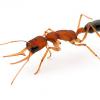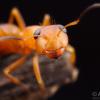Location of collection: South Dakota
Date of Capture: April 26th, 2020
Location of collection: South Dakota
Date of collection: April 26th, 2020 (irrelevant, as this was a colony, not a dealate queen)
Habitat of collection: Lightly forested area, primarily deciduous trees, collected under a rock, many open fields nearby, within blocks from a suburban environment
Length: (workers) 4-6 mm
Coloration: Dark red to black, young workers have bright red mesosomas
Distinguishing characteristics:
Anything else distinctive:
Nest description: Shallow, under a stone (typical of Myrmica)
Nuptial flight time and date:
This is the only clear(ish) shot I could get:

My guess would be M. americana, but I thought I'd check with you guys.





















